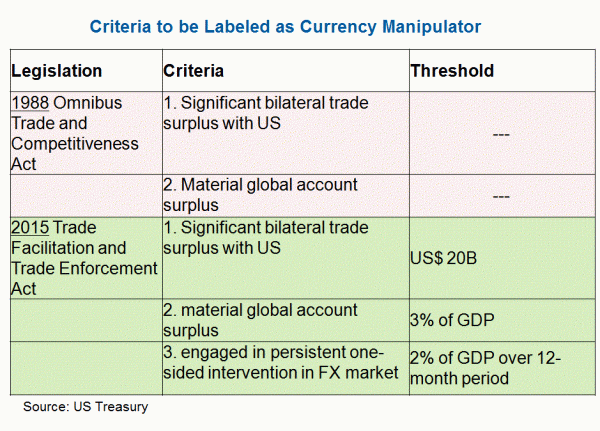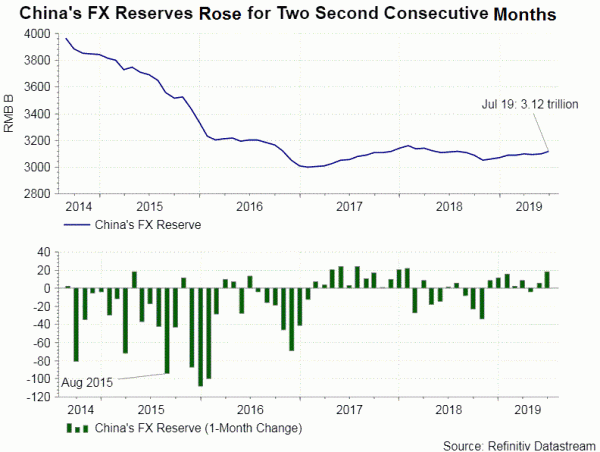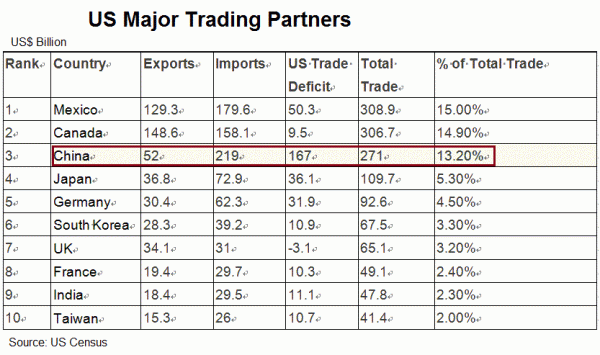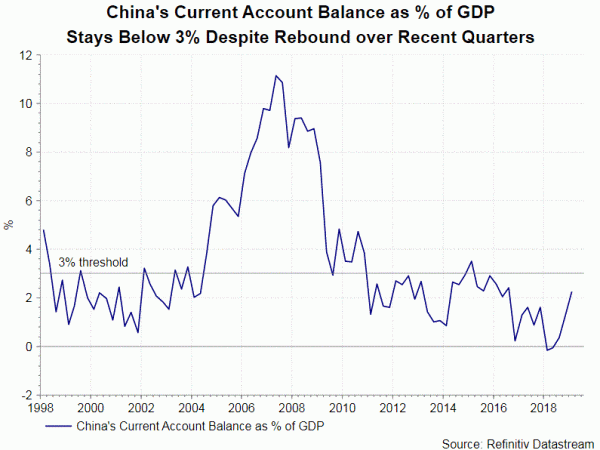US Treasury Department on Monday labeled as currency manipulator, first time since 1994. Before the announcement, Trump has threatened to label as currency manipulator while the Treasury Department has long placed China in its monitoring list. According to the criteria, set by the Treasury Department in 2015, for a country susceptible to be manipulating its currency, we do not believe China should be labeled as one. Yet, we interpret the move as further escalation of the trade war, in addition to imposition of 10% tariff ib the remaining US$300 of Chinese exports to US. We believe it is now more challenging for US and China to reach a trade deal before US presidential election in 2020. Meanwhile, retaliatory actions from China would exacerbation its economic slowdown. We expect PBOC to accelerate monetary easing including RRR cut and rate cuts later in the year.
According to Section 701 of the Trade Facilitation and Trade Enforcement Act of 2015, criteria for US’ trading partners susceptible to be currency manipulator are (1) a significant bilateral trade surplus with the United States (trade surplus of above US$20 billion with the US), (2) a material current account surplus, and (3) engaged in persistent one-sided intervention in the foreign exchange market.
 The following table shows that China has a trade surplus of US$ 167B with the US in the first half of the year, significantly above what is required in criteria 1. China’s current account surplus as % of GDP skyrocketed in 2005 before reaching the peak in 2017. Yet, the trend has reversed since the Global Financial Crisis in 2007/08. China’s current account surplus has not reached 3% of its GDP since 2Q15. The US is most concerned about China intervening the FX market to depreciate the renminbi. China’s FX reserve should surge if the authority sell renminbi and buy foreign assets. China’s FX reserve asset increased RMB 46B in the first half of the year, after declining RMB 67B in 2018. There is little sign showing that China has “engaged in persistent one-sided intervention in the foreign exchange market”.
The following table shows that China has a trade surplus of US$ 167B with the US in the first half of the year, significantly above what is required in criteria 1. China’s current account surplus as % of GDP skyrocketed in 2005 before reaching the peak in 2017. Yet, the trend has reversed since the Global Financial Crisis in 2007/08. China’s current account surplus has not reached 3% of its GDP since 2Q15. The US is most concerned about China intervening the FX market to depreciate the renminbi. China’s FX reserve should surge if the authority sell renminbi and buy foreign assets. China’s FX reserve asset increased RMB 46B in the first half of the year, after declining RMB 67B in 2018. There is little sign showing that China has “engaged in persistent one-sided intervention in the foreign exchange market”.
 Although China has only met one of the three criteria mentioned above, the US has designated it as a currency manipulator. We believe this marks further escalation of US-China trade war, in addition to imposition of 10% tariff on the remaining US$300B of Chinese exports.
Although China has only met one of the three criteria mentioned above, the US has designated it as a currency manipulator. We believe this marks further escalation of US-China trade war, in addition to imposition of 10% tariff on the remaining US$300B of Chinese exports.
China certainly would retaliate. In fact, the Ministry of Commerce has already announced that Chinese companies have stopped purchasing US agricultural products. Meanwhile, PBOC has allowed USDCNY to trade above the psychological level of 7. While further depreciation of renminbi is likely, we do not expect China would allow excessive selloff of its currency as it would trigger massive capital outflow. Going forward, PBOC would speed up implementation of monetary policy. We expect to see further reduction in RRR and interest rate in coming months.















